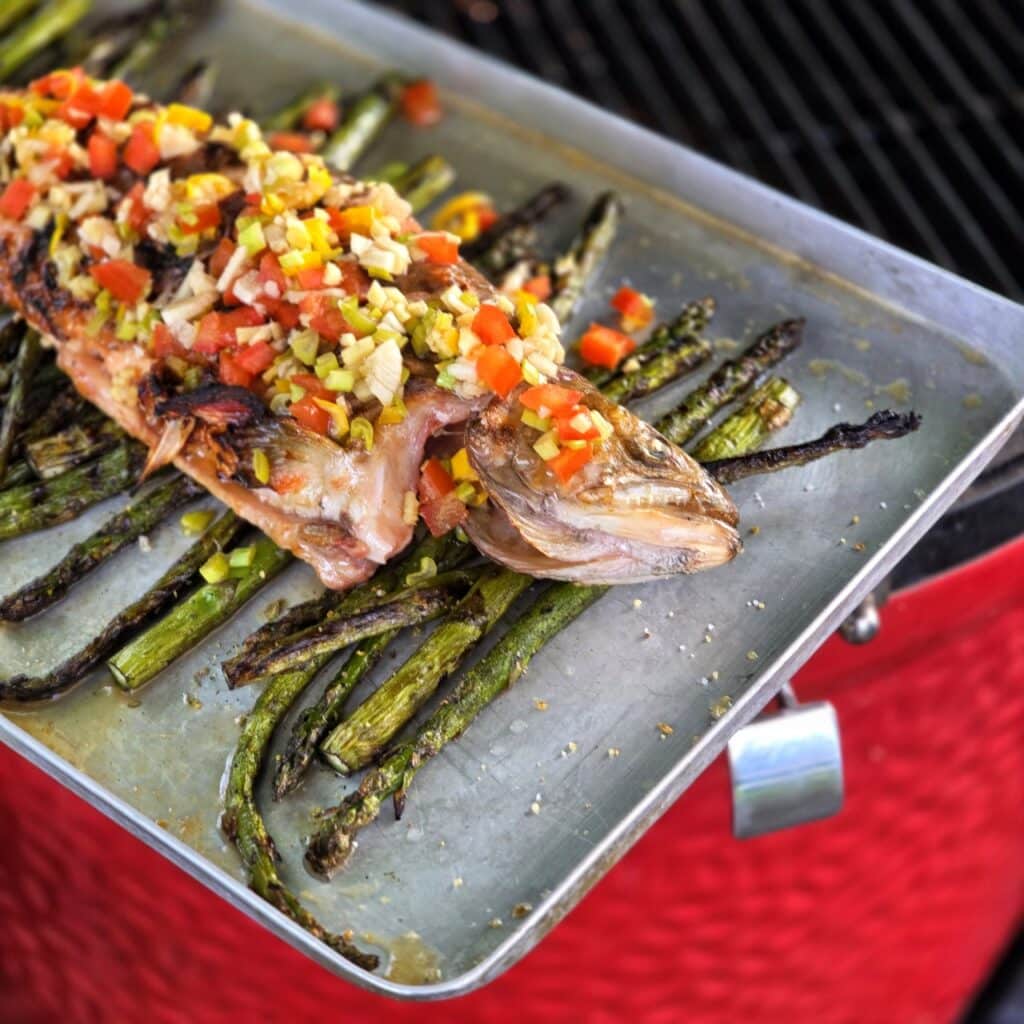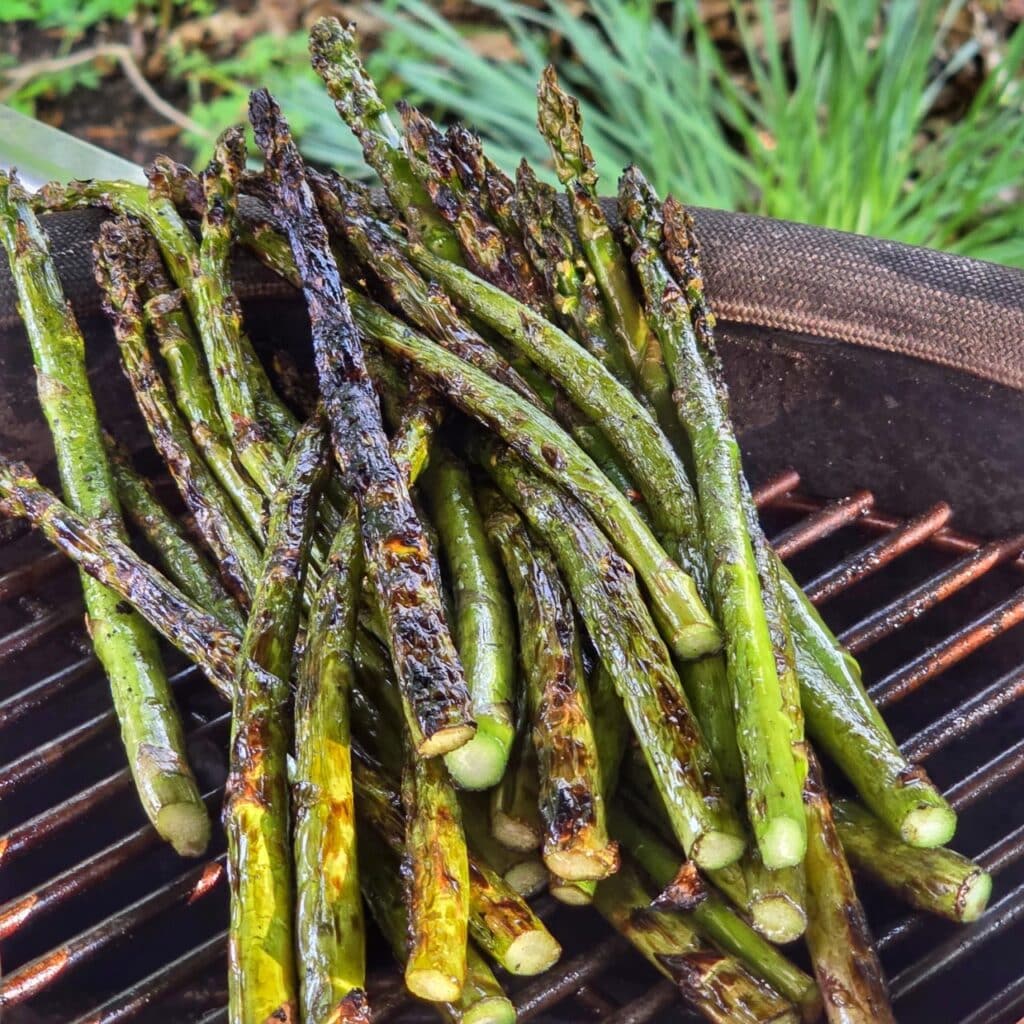If there’s one fish that manages the balancing act between delicate texture and strong flavor with ease, it’s char. In my last recipe, I steam-cooked it – Thai-inspired, aromatic, restrained, almost meditative. A dish that whispers rather than shouts. Here is grilled char.
This time it’s over the fire. And although the char has such a noble appearance, it is by no means too fine for the grill. On the contrary: its structure, fat content and character make it an ideal candidate for the embers – provided you treat it with the necessary care. Combined with green asparagus and a Thai sauce, it makes a feast.

And if you want char in outstanding Ikejime quality (more on this below), then fischkaufhaus.de is your address. By the way, with my code “chopstick10” you save 10% on every order.
Why char at all?
Char is a fish that is often underestimated in our latitudes. While salmon has ended up in mass production and trout is almost boring, char remains something special. Its flesh is light, fine-grained and has a subtly nutty, slightly buttery flavor that sets it apart from other freshwater fish. It is really good when grilled.
It also contains lots of healthy omega-3 fatty acids – not quite on a par with salmon, but significantly higher than trout or zander. What’s more, char are often kept in small, sustainable farms, which favors quality and freshness – especially if you are specifically looking for Ikejime quality.

Ikejime – also a game changer on the grill
As already discussed in detail in the recipe for steamed char, the Japanese Ikejime method ensures a particularly high-quality texture and a clear taste – almost “pure” in the best sense of the word. The method minimizes stress hormones in the meat, prevents blood congestion and promotes even maturing.
With grilled char, this manifests itself in the form of better cohesion of the meat (no falling apart), less escaping liquid and more aroma with a more subtle fish taste. The result: a fillet or whole fish that lifts cleanly from the grill while retaining its juiciness.
Barbecuing with respect – how to succeed
A fish like char doesn’t need a riot. If you do too much – too much smoke, too much heat, too much marinade – you run the risk of masking its delicate flavors. The motto is: less is more. The Gehlsbach char was therefore simply incised beforehand and treated with lime juice and salt. That’s enough, as the Thai sauce is still to come….

It is also important – as here on the Kamado Joe – not to turn the char too often, otherwise the skin will stick to the grill. It shouldn’t get too hot either, so it’s better to keep the grill on top and not let the charcoal glow like hell.
Side dishes that celebrate the grilled char
Grilled char is a delicate, restrained fish – its accompaniments should support it, not overwhelm it. Many things go well with it, not just the Thai sauce used here. For example, you could just add a few lime halves or grill pak chou with sesame oil. But you can also follow my approach and serve it with grilled green asparagus with wonderful camelina oil from Der Ölacker.

The Thai sauce – the icing on the cake
Did I mention the Thai sauce? Now, now! As is so often the case in Thai cuisine, it’s all about a combination of flavors – spicy, sweet, sour and salty. I focus here on sour, combined with a slight sweetness and spiciness. The ingredients are water, fish sauce, sugar, tamarind paste, garlic, ginger, chili, lime juice, spring onions and tomatoes. All you have to do with all this is chop it up, heat it up and dissolve the sugar. You will find the exact quantities below in the recipe, but try it out, make it spicier, sweeter, etc… according to your preferences.

Conclusion: Char on the grill – underestimated, but terrific
The char is one of those fish that is often overlooked – especially in BBQ circles. Yet it has everything we value on the barbecue: Aroma, structure, bite, elegance. If you want to avoid industrial salmon fillets but are still looking for fish with character, you’ll find it here.
And combined with the Ikejime method, the result is a product that is not only tasty but also ethical – regardless of whether you steam it gently or celebrate it proudly over the embers. Combined with green asparagus and Thai sauce…what can I say – I love it!
Print
Gegrillter Saibling auf Spargel mit Thai Sauce
- Total Time: 2 hours 35 minutes
Ingredients
1 Saibling
1/2 Limette
Salz
Gründer Spargel
Leindotteröl
Für die Thai Sauce:
60 ml Wasser
3 EL Fischsauce
2 EL Zucker
2 EL Tamarindenpaste
Saft einer Limette
2 Frühlingszwiebeln, in Ringen
2 Knoblauchzehen, klein gehackt
3 cm Ingwer, klein gehackt
1 Tomate, Fruchtfleisch klein geschnitten
1–2 Chilis, nach Belieben, klein geschnitten
Instructions
Den Saibling von beiden Seiten mehrmals im Fleisch einschneiden. Anschließend innen und außen mit Limettensaft und Salz würzen. Den grünen Spargel mit Leindotteröl benetzen.
Den Grill auf mittlere direkte Hitze hochheizen. Den Saibling und den Spargel auf dem Rost grillen. Den Saibling dabei frühestens nach 3 Minuten und insgesamt nicht allzu oft wenden, damit die Haut nicht am Rost pappt und abgeht. Den Spargel wiederholt wenden. Darauf achten, dass die Spargelspitzen weniger Hitze abbekommen, da diese schneller gar sind.
In den letzten Minuten des Garprozesses alle Zutaten der Thai Sauce in einem Top erhitzen und verrühren. Den Zucker dabei auflösen und kurz aufkochen lassen.
Den Saibling auf einem Spargelbett servieren. Den Saibling dann mit der Thai Sauce begießen und ein Festmahl genießen.
- Prep Time: 20 Minuten
- Cook Time: 15 Minuten
- Method: Grillen
- Cuisine: Thailändisch



